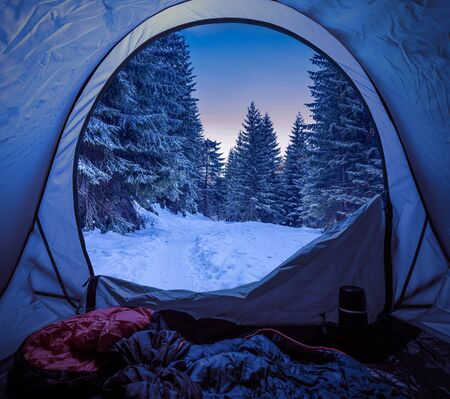1. Essential Cold-Weather Clothing
Layering is key for winter camping. The right clothing system will help you regulate your body temperature, manage moisture, and stay protected from wind and snow. There are three main layers youll need: a base layer, an insulating mid-layer, and a waterproof outer layer.
Base Layers
Your base layer sits directly against your skin and helps wick away sweat to keep you dry. Avoid cotton—once it gets wet, it stays wet. Instead, go with moisture-wicking materials like merino wool or synthetic fabrics.
| Item | Recommended Material | Purpose |
|---|---|---|
| Thermal Top | Merino Wool or Polyester | Keeps core warm and dry |
| Thermal Bottoms | Merino Wool or Polyester | Insulates lower body |
| Socks (2-3 pairs) | Wool Blend | Prevents cold feet and blisters |
Mid-Layers
The mid-layer provides insulation by trapping heat close to your body. Depending on how cold it is, you might need multiple mid-layers. Fleece jackets, down puffies, or synthetic insulated hoodies all work great.
| Item | Material Options | Purpose |
|---|---|---|
| Fleece Jacket or Pullover | Polyester Fleece | Adds warmth without bulk |
| Insulated Jacket | Down or Synthetic Insulation | Main source of warmth in cold temps |
Outer Layers (Shells)
This is your first line of defense against wind, snow, and rain. Your shell layer should be waterproof and breathable to keep the elements out while allowing sweat to escape.
| Item | Features to Look For | Purpose |
|---|---|---|
| Waterproof Jacket (Hard Shell) | Taped seams, breathable membrane (e.g., Gore-Tex) | Keeps upper body dry and blocks wind |
| Waterproof Pants (Shell Pants) | Zippered legs, reinforced cuffs, breathable fabric | Protects legs from snow and moisture |
Accessories You Shouldnt Forget
- Warm Hat: A fleece-lined beanie or wool hat helps retain heat.
- Neck Gaiter or Balaclava: Protects your face from biting wind.
- Gloves or Mittens: Layered gloves work best—liner gloves under insulated mittens.
- Gaiters: Keep snow out of your boots during hikes or deep powder conditions.
- Campsite Footwear: Insulated booties or waterproof camp shoes for comfort around camp.
Dressing smart with the right layers can make all the difference between a fun winter adventure and a miserable one. Always bring extra socks and gloves in case they get wet—you’ll thank yourself later!
2. Four-Season Shelter and Sleep System
Staying warm and dry during winter camping starts with the right shelter and sleep system. Cold weather trips demand gear that can handle snow, wind, and freezing temperatures. That means investing in a solid four-season tent, an insulated sleeping pad, and a winter-rated sleeping bag.
Four-Season Tent
A four-season tent is built to withstand harsh weather conditions like heavy snowfall and strong winds. Unlike three-season tents, these have sturdier poles, reinforced fabrics, and fewer mesh panels to keep warmth in and snow out. Look for features like snow flaps, high-denier fabric, and a low-profile design to reduce wind resistance.
Recommended Features:
| Feature | Why It Matters |
|---|---|
| Double-wall construction | Helps manage condensation and adds insulation |
| Strong pole structure | Supports the tent under snow load and high winds |
| Minimal mesh | Keeps cold air out while retaining heat inside |
Insulated Sleeping Pad
The ground can suck the heat right out of you if youre not properly insulated. An insulated sleeping pad with a high R-value (5 or above) is essential for creating a barrier between you and the frozen ground. Foam pads can be layered under inflatable ones for extra warmth and durability.
Pro Tip:
Use a closed-cell foam pad beneath your inflatable pad to boost insulation and protect against punctures.
Winter-Rated Sleeping Bag
Your sleeping bag should be rated at least 10°F lower than the coldest temperature you expect to encounter. Down bags are lighter and compress better but lose insulation when wet; synthetic bags retain warmth even when damp. Make sure it has a draft collar, hood, and zipper baffle to lock in heat.
Sleeping Bag Temperature Ratings Guide:
| Temperature Range (°F) | Recommended Use |
|---|---|
| -20°F to 0°F | Extreme winter conditions or alpine camping |
| 0°F to 15°F | Typical winter camping in most U.S. regions |
| 15°F to 30°F | Mild winter climates or shoulder seasons |
How to Insulate Your Sleep Setup for Maximum Warmth
Layer Up Your Sleep System:
- Add a sleeping bag liner: Increases warmth by up to 10°F.
- Use two pads: Combine foam and inflatable pads for better insulation.
- Wear dry thermal layers: Keep moisture away from your skin while you sleep.
- Stuff clothes around cold spots: Fill gaps inside your bag to reduce dead air space.
A well-insulated sleep system isnt just about comfort—its essential for safety on cold weather trips. Investing in quality gear now means warmer nights and better rest when temperatures drop outside your tent walls.
![]()
3. Cold-Weather Cooking and Food Storage
Cooking in cold weather comes with its own set of challenges, but with the right gear and a little prep, you can still enjoy hot, hearty meals at camp. When temperatures drop, standard camping stoves may struggle to perform, and food or water can freeze quickly if not properly stored.
Winter-Ready Stoves and Cookware
Not all stoves work well in freezing temperatures. For winter camping, choose a stove that’s designed for cold weather—liquid fuel stoves are often more reliable than canister stoves when it gets really cold. Also, opt for cookware that heats quickly and retains warmth, like aluminum or hard-anodized pots.
Recommended Winter Cooking Gear
| Item | Description |
|---|---|
| Liquid Fuel Stove | Performs better than canister stoves in sub-freezing temps |
| Windscreen | Improves stove efficiency and conserves fuel |
| Insulated Mug or Pot Cozy | Keeps meals warm longer after cooking |
| Long-Handled Spoon | Makes stirring and eating from deep pots easier while wearing gloves |
Keep Your Food from Freezing
Food storage is crucial in winter. Items like fruits, energy bars, and even canned goods can freeze solid overnight. Store perishables in insulated bags or containers and keep them inside your tent or sleeping bag if needed. Choose foods that stay soft or edible even when cold—think jerky, nuts, and dried fruit.
Cold-Weather Food Tips:
- Pre-cut ingredients at home to save time and reduce exposure to the cold
- Avoid foods with high water content that are prone to freezing
- Pack high-calorie snacks to fuel your body in the cold
- Use vacuum-sealed pouches for soups and stews—they reheat easily in boiling water
Hydration: Don’t Let Your Water Freeze
Staying hydrated is just as important in winter as it is in summer. Insulated water bottles and thermoses help prevent freezing and keep drinks warm throughout the day. Avoid using hydration bladders unless they have insulated tubes, as these tend to freeze quickly.
Hydration Essentials for Winter Camping:
| Item | Why You Need It |
|---|---|
| Insulated Water Bottle (e.g., Hydro Flask) | Keeps water from freezing during the day or night |
| Thermos for Hot Drinks | Makes it easy to enjoy coffee, tea, or soup on the go |
| Wide-Mouth Bottle (e.g., Nalgene) | Easier to pour into and less likely to freeze shut; can be used as a hot water bottle in your sleeping bag at night |
| Bottle Insulator Sleeve | Adds extra protection against freezing temps when carrying bottles outside your pack |
With the right setup, you can enjoy delicious meals and stay hydrated—even when its freezing out. Taking time to plan your food strategy can make a huge difference in your overall comfort and energy levels during a winter camping trip.
4. Safety and Emergency Gear
Don’t head into the backcountry unprepared. Winter camping can be unpredictable, and having the right safety and emergency gear could mean the difference between a minor mishap and a serious situation. Below are essential items every cold-weather camper should pack to stay safe and ready for anything.
Avalanche Safety Gear
If youre venturing into mountainous terrain or areas with heavy snowfall, avalanche safety gear is non-negotiable. Even if you’re just hiking near potential avalanche zones, being equipped and trained can save lives.
| Item | Description |
|---|---|
| Avalanche Beacon (Transceiver) | Sends and receives signals to help locate buried individuals. |
| Probe | Used to pinpoint the exact location of someone buried under snow. |
| Shovel | Compact and sturdy shovel for digging out snow quickly. |
Navigation and Communication Tools
Getting lost in the winter wilderness is dangerous. Shorter daylight hours and snowy conditions can make landmarks hard to recognize. Bring reliable tools to keep your bearings and stay in touch.
- GPS Tracker: Devices like Garmin inReach let you track your route and send SOS signals even without cell service.
- Map & Compass: Always carry a physical map and compass as backups—batteries can die fast in the cold.
- Whistle: A simple whistle can help you alert others if youre in trouble or separated from your group.
First Aid Kit
Your first aid kit should be tailored for cold-weather injuries like frostbite, hypothermia, and slips on icy terrain. Pack it with extra supplies you might not need during summer trips.
- Thermal blanket (space blanket)
- Hand warmers for treating mild frostbite or warming extremities
- Adhesive bandages, gauze pads, antiseptic wipes, medical tape
- Pain relievers, tweezers, scissors, blister treatment
Personal Warmth and Survival Essentials
Staying warm isn’t just about comfort—it’s about survival. Make sure you have these key items on hand to maintain body heat and protect against extreme elements.
| Item | Description |
|---|---|
| Hand & Foot Warmers | Chemical warmers that provide heat for several hours—perfect for gloves or boots. |
| Emergency Shelter | Bivy sack or lightweight emergency tent to use if youre stranded away from your main campsite. |
| Fire Starter Kit | Waterproof matches, fire starter cubes, or ferro rods to build a fire in any condition. |
| Multi-tool or Knife | A versatile tool for cutting wood, repairing gear, or emergency situations. |
Pro Tips for Safety Gear Use
- Always test your avalanche beacon before heading out—it should be fully charged and functional.
- Pretend its going to get colder than forecasted; pack accordingly.
- If youre new to using GPS devices or avalanche equipment, take a short course or watch tutorials before your trip.
- Create an emergency plan with your group so everyone knows what to do if something goes wrong.
Packing smart safety gear means you can enjoy the beauty of winter camping while staying prepared for whatever Mother Nature throws your way.
5. Winter-Specific Camping Tools and Accessories
Winter camping brings its own set of challenges, so having the right tools and accessories can make a big difference in your comfort and safety. This section covers essential winter-specific gear that helps you stay prepared when cold weather conditions kick in.
Snow Shovels
A sturdy snow shovel is a must-have for clearing campsites, building windbreaks, or digging out your tent if it gets buried overnight. Look for lightweight models with collapsible handles to save space in your pack.
Traction Devices
Icy trails and slick surfaces are common hazards during winter trips. Traction devices like microspikes or crampons give your boots extra grip and help prevent slips and falls. These are especially useful if youre hiking on frozen terrain.
Headlamps with Extra Batteries
Daylight hours are shorter in the winter, so youll rely more on artificial light. A high-quality headlamp keeps your hands free while cooking or setting up camp in the dark. Cold temperatures drain batteries faster than usual, so always carry extras and store them close to your body to preserve their charge.
Fire-Starting Tools
Getting a fire going in wet or snowy conditions can be tough. Pack multiple fire-starting options like waterproof matches, a reliable lighter, and fire starter cubes or sticks. It’s always smart to have backups just in case one method fails.
Quick Reference Gear Table
| Item | Purpose | Tips |
|---|---|---|
| Snow Shovel | Clear snow, dig shelter spots | Choose foldable models for easy packing |
| Traction Devices | Add grip on icy surfaces | Select ones compatible with your boots |
| Headlamp + Batteries | Hands-free lighting after dark | Use lithium batteries for better cold performance |
| Fire Starters | Start fires in tough conditions | Cotton balls soaked in petroleum jelly make great DIY starters |
Packing these winter-specific tools ensures youre ready to tackle whatever the season throws at you—whether its deep snow, icy trails, or long nights at camp.


